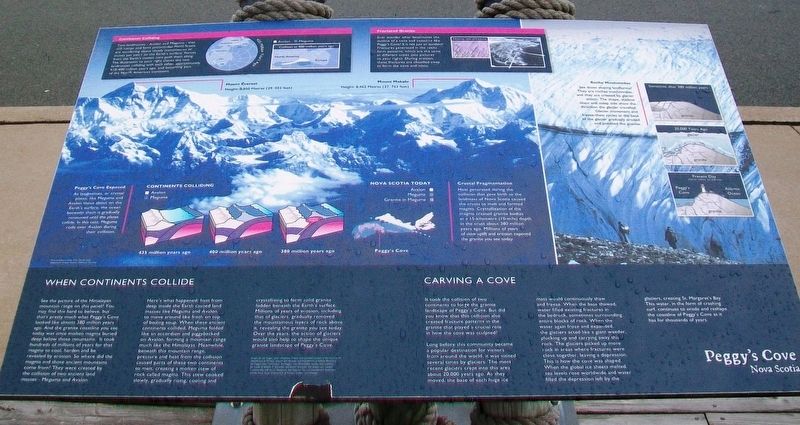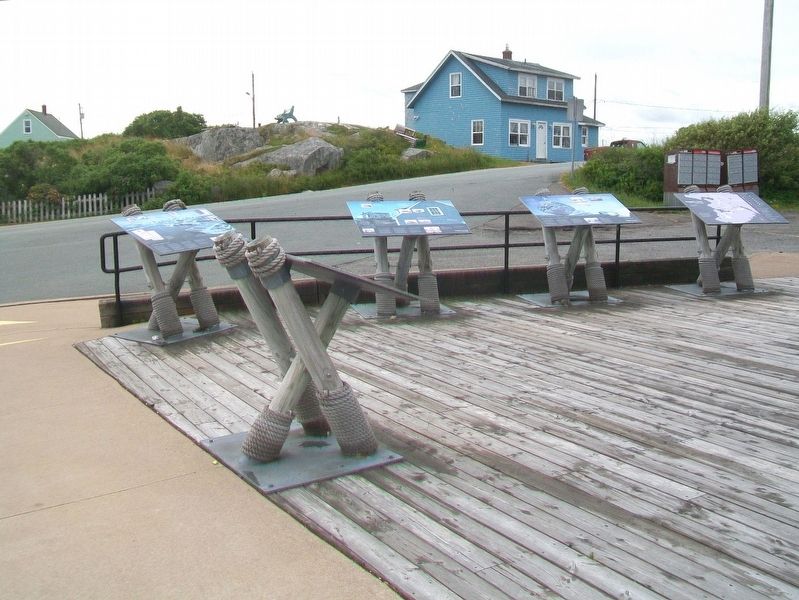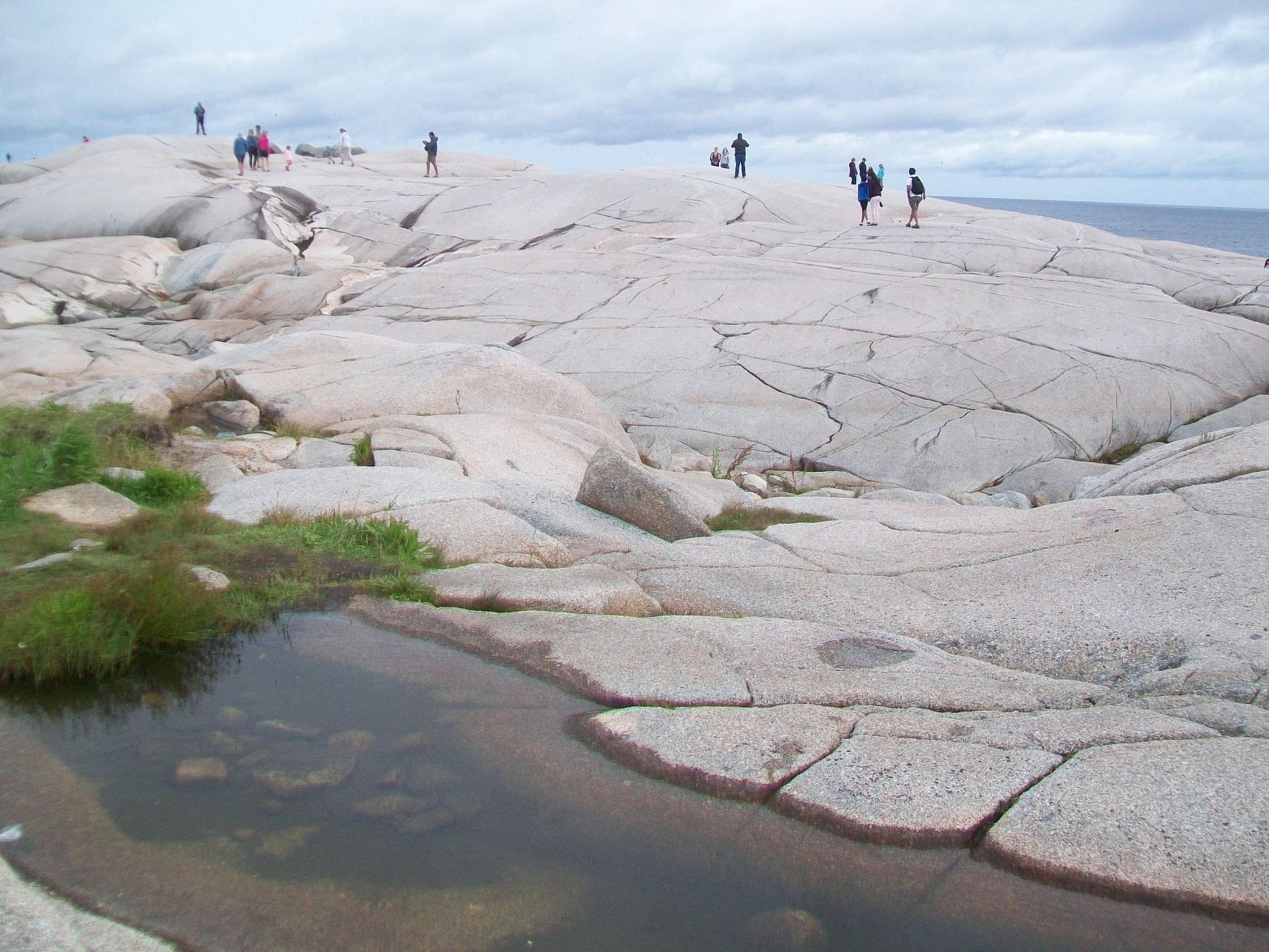When Continents Collide / Carving A Cove
When Continents Collide
See the picture of the Himalayan mountain range on this panel? You may find this hard to believe, but that's pretty much what Peggy's Cove looked like almost 380 million years ago. And the granite coastline you see today was once molten magma buried deep below those mountains. It took hundreds of millions of years for that magma to cool, harden and be revealed by erosion. So where did the magma and those ancient mountains come from? They were created by the collision of two ancient land masses - Meguma and Avalon.
Here's what happened: heat from deep inside the Earth caused land masses like Meguma and Avalon to move around like froth on top of boiling soup. When these ancient continents collided, Meguma folded like an accordion and piggybacked on Avalon, forming a mountain range much like the Himalayas. Meanwhile, beneath this mountain range, pressure and heat from the collision caused parts of these two continents to melt, creating a molten stew of rock called magma. This stew cooked slowly, gradually rising, cooling and crystallizing to form solid granite hidden beneath the Earth's surface. Millions of years of erosion, including that of glaciers, gradually removed the mountainous layers of rock above it, revealing the granite you see today. Over the years, the action of glaciers would also
help to shape the unique granite landscape of Peggy's Cove.
Peggy's Cove Exposed
As landmasses, or crustal plates, like Meguma and Avalon move about on the Earth's surface, the ocean between them is gradually consumed until the plates collide. In this case, Meguma rode over Avalon during their collision.
Crustral Fragmentation
Heat generated during the collision that gave birth to the landmass of Nova Scotia caused the crusts to melt and formed magma. Crystallization of the magma created granite bodies at a 15-kilometre (10-mile) depth in the crust about 380 million years ago. Millions of years of slow uplift and erosion exposed the granite you see today.
[Theorized drawing of Meguma and Avalon at] 430 • 400 • 380 million years ago
[Top Left] Continents Colliding
Two landmasses - Avalon and Meguma - that will merge and form present-day Nova Scotia are wandering about slowly (centimetres or inches per year) on the Earth's surface. Forces from the Earth's molten core push them along. The illustration to your right shows the two landmasses colliding with each other, approximately 410-400 million years ago, and becoming part of the North American continent.
Carving a Cove
It took the collision of two continents to forge the granite landscape of Peggy's Cove. But did you know that this collision also created fracture patterns
Long before this community became a popular destination for visitors from around the world, it was visited several times by glaciers. The most recent glaciers crept into this area about 20,000 years ago. As they moved, the base of each huge ice mass would continuously thaw and freeze. When the base thawed, water filled existing fractures in the bedrock, sometimes surrounding entire blocks of rock. When the water again froze and expanded, the glaciers acted like a giant weeder, plucking up and carrying away this rock. The glaciers picked up more rock in areas where fractures were close together, leaving a depression. This is how the cove was shaped. When the global ice sheets melted, sea levels rose worldwide and water filled the depression left by the glaciers, creating St. Margaret's Bay. This water, in the form of crashing surf, continues to erode and reshape the coastline of Peggy's Cove as it has for thousands of years.
[Top center] Fractured Granite
Ever wonder what determines the outline of a cove and coastline like Peggy's Cove? It is not just an accident! Fractures generated in the rocks form patterns, which are the same at different scales (see pictures to your right). During erosion, these fractures are chiselled away to form the cove and inlets.
Roche Moutonnées
See those
Topics. This historical marker is listed in this topic list: Natural Features.
Location. 44° 29.637′ N, 63° 54.824′ W. Marker is in Peggy's Cove, Nova Scotia, in Halifax Region. Marker is on Peggy's Pointe Road, 0.4 kilometers Prospect Road (Nova Scotia Route 333), on the left when traveling south. Marker is at the Nova Scotia Provincial Visitor Information Centre. Touch for map. Marker is at or near this postal address: 96 Peggy's Cove Road, Peggy's Cove NS B3Z 3S2, Canada. Touch for directions.
Other nearby markers. At least 8 other markers are within walking distance of this marker. The Lure of Peggy's Cove (here, next to this marker); Home Sweet Home (here, next to this marker); The Cold, Hard Facts About Glaciers (here, next to this marker); Peggy's Cove (a few steps from this marker); Fishermen's Monument (within shouting distance of this marker); A Monumental Work Of Art (within shouting distance of this marker); The Art of deGarthe (within shouting distance of this marker); A Natural Masterpiece (within shouting distance of this marker). Touch for a list and map of all markers in Peggy's Cove.
Also see . . .
1. Introduction to the Geological History of Nova Scotia. Nova Scotia Museum of Natural History website entry (Submitted on January 12, 2018, by William Fischer, Jr. of Scranton, Pennsylvania.)
2. Peggy's Cove, Nova Scotia. YouTube video (2m 35) (Submitted on January 12, 2018, by William Fischer, Jr. of Scranton, Pennsylvania.)
Credits. This page was last revised on April 23, 2024. It was originally submitted on January 12, 2018, by William Fischer, Jr. of Scranton, Pennsylvania. This page has been viewed 226 times since then and 16 times this year. Photos: 1, 2, 3. submitted on January 12, 2018, by William Fischer, Jr. of Scranton, Pennsylvania.


